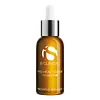What's inside
What's inside
 Key Ingredients
Key Ingredients

 Benefits
Benefits

 Concerns
Concerns

No concerns
 Ingredients Side-by-side
Ingredients Side-by-side

Water
Skin ConditioningCaprylic/Capric Triglyceride
MaskingGlycerin
HumectantSodium Acrylates Copolymer
Squalane
EmollientSodium Ascorbate
AntioxidantUbiquinone
AntioxidantEctoin
Skin ConditioningPhysalis Angulata Extract
Skin ProtectingBetaine
HumectantPhosphatidylcholine
EmulsifyingCamellia Sinensis Leaf Extract
AntimicrobialCarnosine
Skin ConditioningCentella Asiatica Extract
CleansingOlea Europaea Leaf Extract
PerfumingZingiber Officinale Root Extract
MaskingErgothioneine
AntioxidantDunaliella Salina Extract
Skin ConditioningPunica Granatum Fruit Extract
AntioxidantBisabolol
MaskingLactoferrin
Skin ConditioningTremella Fuciformis Sporocarp Extract
AntioxidantPolyglyceryl-10 Laurate
Skin ConditioningCetyl Alcohol
EmollientSodium Benzoate
MaskingXanthan Gum
EmulsifyingTocopherol
AntioxidantHelianthus Annuus Seed Oil
EmollientPropanediol
SolventTocopheryl Acetate
AntioxidantCaprylyl Glycol
EmollientMannitol
HumectantLecithin
EmollientPhenoxyethanol
PreservativeC12-15 Alkyl Benzoate
AntimicrobialEthylhexylglycerin
Skin ConditioningCaprylhydroxamic Acid
Citric Acid
BufferingPotassium Sorbate
PreservativeWater, Caprylic/Capric Triglyceride, Glycerin, Sodium Acrylates Copolymer, Squalane, Sodium Ascorbate, Ubiquinone, Ectoin, Physalis Angulata Extract, Betaine, Phosphatidylcholine, Camellia Sinensis Leaf Extract, Carnosine, Centella Asiatica Extract, Olea Europaea Leaf Extract, Zingiber Officinale Root Extract, Ergothioneine, Dunaliella Salina Extract, Punica Granatum Fruit Extract, Bisabolol, Lactoferrin, Tremella Fuciformis Sporocarp Extract, Polyglyceryl-10 Laurate, Cetyl Alcohol, Sodium Benzoate, Xanthan Gum, Tocopherol, Helianthus Annuus Seed Oil, Propanediol, Tocopheryl Acetate, Caprylyl Glycol, Mannitol, Lecithin, Phenoxyethanol, C12-15 Alkyl Benzoate, Ethylhexylglycerin, Caprylhydroxamic Acid, Citric Acid, Potassium Sorbate
Water
Skin ConditioningAscorbic Acid
AntioxidantLaureth-4
EmulsifyingAlcohol Denat.
AntimicrobialPentylene Glycol
Skin ConditioningPropylene Glycol
HumectantTriethanolamine
BufferingTocopherol
AntioxidantGlycerin
HumectantBioflavonoids
Skin ConditioningRetinol
Skin ConditioningOlea Europaea Leaf Extract
PerfumingZinc Sulfate
AntimicrobialPolyporus Umbellatus Extract
Skin ProtectingArbutin
AntioxidantPolysorbate 20
EmulsifyingPhenoxyethanol
Preservative
 Reviews
Reviews

Ingredients Explained
These ingredients are found in both products.
Ingredients higher up in an ingredient list are typically present in a larger amount.
Glycerin is already naturally found in your skin. It helps moisturize and protect your skin.
A study from 2016 found glycerin to be more effective as a humectant than AHAs and hyaluronic acid.
As a humectant, it helps the skin stay hydrated by pulling moisture to your skin. The low molecular weight of glycerin allows it to pull moisture into the deeper layers of your skin.
Hydrated skin improves your skin barrier; Your skin barrier helps protect against irritants and bacteria.
Glycerin has also been found to have antimicrobial and antiviral properties. Due to these properties, glycerin is often used in wound and burn treatments.
In cosmetics, glycerin is usually derived from plants such as soybean or palm. However, it can also be sourced from animals, such as tallow or animal fat.
This ingredient is organic, colorless, odorless, and non-toxic.
Glycerin is the name for this ingredient in American English. British English uses Glycerol/Glycerine.
Learn more about GlycerinOlive tree leaves contain more antioxidants than olive fruit.
This is due to its rich flavonoid and polyphenol content. However, the antioxidant content varies depending on plant variety, harvesting method, leaf maturity, and extraction method.
This ingredient also has a natural fragrance. Read more about fragrance in cosmetics here.
Learn more about Olea Europaea Leaf ExtractPhenoxyethanol is a preservative that has germicide, antimicrobial, and aromatic properties. Studies show that phenoxyethanol can prevent microbial growth. By itself, it has a scent that is similar to that of a rose.
It's often used in formulations along with Caprylyl Glycol to preserve the shelf life of products.
Tocopherol (also known as Vitamin E) is a common antioxidant used to help protect the skin from free-radicals and strengthen the skin barrier. It's also fat soluble - this means our skin is great at absorbing it.
Vitamin E also helps keep your natural skin lipids healthy. Your lipid skin barrier naturally consists of lipids, ceramides, and fatty acids. Vitamin E offers extra protection for your skin’s lipid barrier, keeping your skin healthy and nourished.
Another benefit is a bit of UV protection. Vitamin E helps reduce the damage caused by UVB rays. (It should not replace your sunscreen). Combining it with Vitamin C can decrease sunburned cells and hyperpigmentation after UV exposure.
You might have noticed Vitamin E + C often paired together. This is because it is great at stabilizing Vitamin C. Using the two together helps increase the effectiveness of both ingredients.
There are often claims that Vitamin E can reduce/prevent scarring, but these claims haven't been confirmed by scientific research.
Learn more about TocopherolWater. It's the most common cosmetic ingredient of all. You'll usually see it at the top of ingredient lists, meaning that it makes up the largest part of the product.
So why is it so popular? Water most often acts as a solvent - this means that it helps dissolve other ingredients into the formulation.
You'll also recognize water as that liquid we all need to stay alive. If you see this, drink a glass of water. Stay hydrated!
Learn more about Water